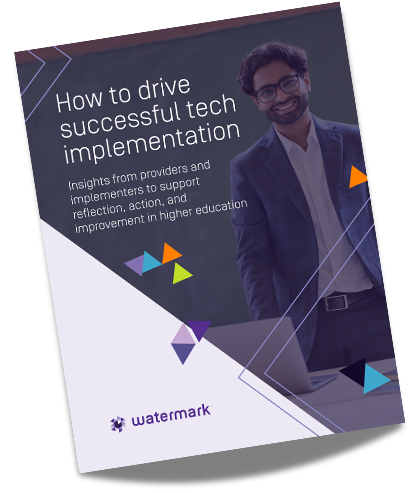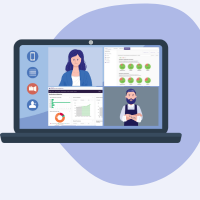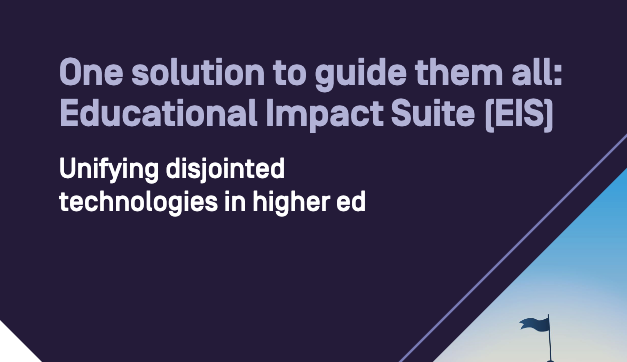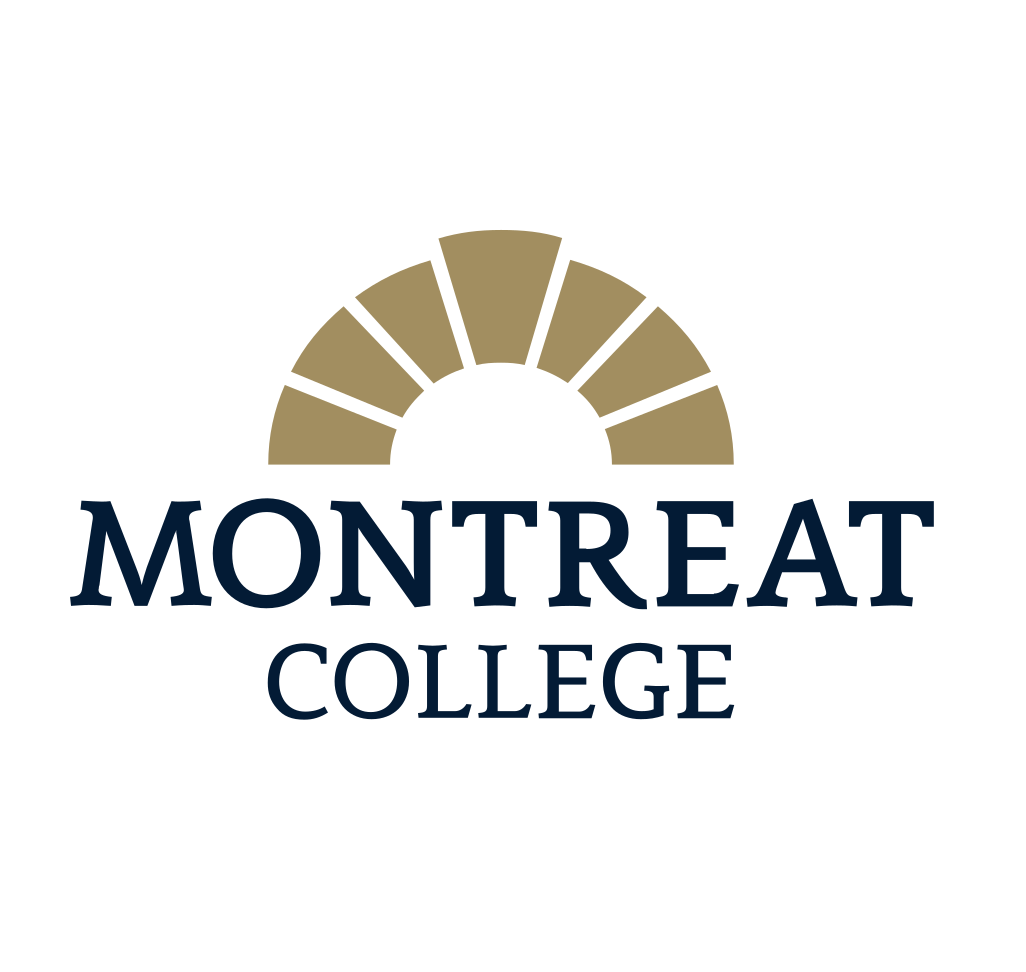How to drive successful tech implementation
Campuses are increasingly turning to a collection of technology solutions to enhance their institutional effectiveness and improve student success. But these solutions’ ability to accomplish their intended purpose relies on how well they are integrated with existing processes.
In this eBook, get insights from providers and implementers as you introduce tech solutions on your campus. While it may be leveraged effectively across the implementation life cycle, this resource is best used in the early stages of tech stack redesign. Institutions can use it to assess readiness for tech investment, align on which features would benefit teams the most, and refine the implementation process.
Learn more about insights from providers and implementers to support reflection, action, and improvement in higher education
Download Now

The efficacy of new tech often relies on the culture, campus conditions, and context in which it is placed. Without a strong leadership team that has the commitment and bandwidth to see a tech procurement project through, initiatives can falter or stall. This section provides several guiding questions and considerations to help teams assess whether they are set up for success or have gaps that need remedying before buying and implementing new tech.
Executive leadershipTech implementations require several levels of commitment and capacity, and it is executive leaders who set the tone for the institution. The president and core executive leadership team must understand the potential of the tech initiative and create space for those deeper in the institution to prioritize the work that comes with quality implementation. They must be prepared to engage in effective budget analysis and plan for the commitment of resources (including staff time), often in a resource-constrained environment. Tech implementation and change management also benefit greatly when executive leaders act as sponsors and champions, actively participating in case-making for internal stakeholders. |
 |
Here are some ways that executive leadership can act as tech champions on their campus:
- Exhibit a willingness to evaluate internal processes and procedures to enable change and better serve students.
- Promote a common mission that empowers all staff to act for the benefit of students.
- Support investment in resources and training.
- Provide clear job expectations for all involved in procurement and implementation.
- Facilitate change management processes with clear, repeated messaging.
Consider:
- To what extent does your institution’s executive leadership exhibit an active commitment to a new tech initiative?
Discussion questions:
- Given these considerations, what may need to be changed or improved?
- What steps might leadership need to take to develop a more involved and supportive role in new tech initiatives?
Mid-level leadershipTech implementations often involve a year or more of intensive, focused work, followed by a commitment to sustainability and continuous improvement. This makes strong implementation teams that attend to the functional and technical or administrative aspects of the work particularly vital to the success of a tech initiative. These implementation teams typically mirror or overlap heavily with the group of individuals the institution assembles to serve as the product procurement team. Early inclusion of mid-level leaders from across a wide range of functional and technical areas throughout the institution, and explicit care in developing a culture of transparency that invites feedback, can significantly improve the pace and quality of implementation. |
 |
Here are some ways that mid-level leaders can contribute to successful tech implementation on campus:
- Demonstrate an understanding of the value of the tool and a commitment to its use.
- Show a willingness and ability to work through the implementation phases.
- Articulate the outcomes they seek.
- Be able to use data effectively to build understanding and trust with frontline faculty and staff affected by implementation.
- Build high-functioning relationships with senior leaders and provide assurance to those deeper in the institution; do this by serving as a buffer and translator between the senior leaders and the frontline faculty and staff who will use the tool.
- Identify stakeholders and know how to translate across silos to build shared understanding and
support for high-quality implementation.
Consider:
- To what extent do you have mid-level leaders who can provide skillful procurement and implementation leadership?
Discussion questions:
- Given these considerations, who at your institution should be included on the procurement/implementation team?
- If a team is already in place, is there evidence that it exemplifies the tenets above?
- How could the team be improved or better supported?
Institutional culture
Tech implementation relies on and touches all facets of an institution. Tech can open access to insights, but it is up to institutions to use those data and insights with integrity and purpose. It is ultimately people, not tech, that make positive change for students; therefore, institutional culture has an enormous impact not only on the quality of implementation but also on how the tech adoption improves student experience and outcomes.
Here are some ways campuses can create a culture for successful tech implementation:
- Exemplify a strong understanding of the student body and a commitment to understanding and prioritizing the lived experience of marginalized and racially minoritized students.
- Remain dedicated to continuous improvement, as evidenced by regular, routine, courageous conversations about student outcomes and the availability of data to identify what is effective for Black, Hispanic/Latino, Indigenous, Asian, and Pacific Islander students and students from low-income backgrounds. What processes or practices may need fine-tuning?
- Establish process and bandwidth to collect and analyze data so that all staff can gain insights that support their roles and responsibilities.
- Present multiple opportunities for professional development and training concerning how to access, understand, and leverage data (e.g., how to use data in operations, how to read data, and how to use the new software).
- Commitment from executive leadership, implementation teams, and other departmental stakeholders to communicate early and often throughout the procurement and implementation stages.
- Build a shared understanding among institutional staff of the difference between retention strategies and student success strategies, and an ability to work on both.
Consider:
- To what extent does your institution have a widely embraced culture of evidence and the ability to collaborate across silos?
Discussion questions:
- How ready is your institutional culture to make the best possible use of tech to support your faculty, staff, and students?
- Where are the biggest challenges and opportunities with respect to strengthening your culture for the successful implementation of tech?
Tech and data ecosystem
Before launching into implementation, institutions must identify and work through any disconnects between the tech and the data ecosystems. Too often, institutions procure tech without considering whether the campus has the level of data hygiene required for implementation. “Dirty” data, such as duplicate records, incomplete or outdated data, and the inaccurate parsing of record fields from disparate systems, can slow or stall implementation. Likewise, unanticipated integration challenges due to the tendency of institutions to procure and stack new products without assessing the readiness of the campus’s tech ecosystem can derail implementation.
Solution providers and tech-savvy institutions both recommend performing the following checks. (Typically, IR and IT are best positioned to weigh in on these considerations.)
Ask yourself the following:
- Do you have clearly defined and broadly accepted data definitions that span departmental units and are used consistently in your existing core systems of record?
- Given your prioritized product capabilities, what kind of data will need to be pulled into the product to allow it to display accurate and actionable information?
- Where are critical student, academic, and other relevant data currently stored (e.g., SIS, pen and paper, Excel)? To what extent can the new product integrate with these core systems, and what work-arounds may be needed to integrate or migrate data sets if full interoperability is not possible (which is often the case)?
- Given your stakeholder needs, how frequently will different information displayed in the product need to be updated to maintain the integrity and user-friendliness of the product? Note that while access to real-time data is ideal, it is not always possible for all data points.
Consider:
- To what extent is your tech and data ecosystem ready for a tech implementation?
Discussion questions:
- Who at your institution needs to be engaged to ensure you are ready to integrate new tech and consistently produce clean data?
- Given these considerations, how ready is your current data ecosystem to make the best possible use of new tech?
- Where are the biggest challenges and opportunities with respect to strengthening your records for the successful implementation of a new tech?
Once leaders feel ready to move forward with a tech initiative, one of the first steps in the planning process involves deciding what product can help meet the desired outcomes. This can be an arduous process given the many competing perspectives across units. While product capabilities and preferences will ultimately vary by institution, this section provides an overview of some of the most common product requirements, organized by stakeholder.
Advisors and student support staff
Universally, advisors and other student support staff say they want a user-friendly “one-stop shop” for all tools, a system that is streamlined and easy to navigate for even the most novice of tech users. They see this as a way to prioritize their efforts and maximize the impact of the time they have with students.
Specifically, these practitioners have most regularly called for the ability to:
|
 |
Students
Students also frequently cite a need for a digital “one-stop shop” to house all of the tools needed across the student experience, from billing and financial aid to course planning and tutoring. Most tools have a student-facing component, though it may be priced differently or separately from advisor- and support-staff-facing tools.
Students and their advocates frequently include the following product capabilities on their wish lists:
- One platform for multiple use cases (e.g., registration, tuition payment, and planning for courses) rather than “jumping around” to different platforms.
- Easy collaboration with advisors and other support staff.
- Customizable communications to receive only the needed notifications or the ability to opt in and out of notifications.
- Clear view and navigation of the product from a mobile phone.
- Alerts about upcoming deadlines and milestones (e.g., alert to meet with an advisor about a low grade, alert about an upcoming financial aid deadline).
- Organization of student journey from entry to present, with a situational awareness viewpoint.
Administrators
It is vital that institutions have both the proper data and the capacity to draw insight from finely disaggregated data to empower effective action for students. Using data effectively to empower students and those who support them is a critical piece of the puzzle. Some tech products offer more robust dashboards, while others prioritize usability. Whereas data dashboard features are often used by executive leadership, student success leads, and IR, they could also be used across a variety of stakeholders, depending on an institution’s data management and privacy/access policies.
Administrators and other leaders often asked for the following capabilities:
- Pull from multiple data sources and core tech systems (e.g., SIS, LMS).
- Define and track specific key performance indicators that executive and mid-level leadership need in order to evaluate initiative and student success.
- User-friendly interface that is easy to navigate for nontechnical staff.
- Display data graphically through engaging data visualization tools.
- View data trends at a high level, as well as data on an individual student level.
- Access for multiple users across departments to view the data dashboard for broadly improved student success.
Consider:
- How ready are you as a campus to translate and use data to drive informed decisions and initiatives?
The following pages include a structured appreciative inquiry dialogue process that is intended to support service providers and institutional partners in the identification of the key campus conditions, tech features and functions, and overarching agreements necessary for the successful implementation of new tech in their particular setting.
Recommended participants
Appreciative inquiry is most effective when a broad set of stakeholders is included; however, this resource was developed with input from smaller groups that included one to three campus representatives from advising, IT, and/or IR departments, as well as one to three solution provider representatives from leadership, research and development, or implementation support roles.
Overview of process
This series of structured dialogues can be facilitated in three separate sessions of about 60 to 90 minutes or one extended session of about four to six hours. These sessions can be self-facilitated using the guide prompts, or a nonparticipating facilitator can be used to help guide the structure of the sessions and support synthesis of ideas.
Session 1: Discover — “The best of what is”
The first dialogue captures “The Best of What Is” through paired interviews and a joint summary of high points related to tech functions and features as well as campus conditions for successful implementation.
STEP 1: INTERVIEWS
Break into interview pairs, ideally including two individuals from different departments or organizations. In this exercise, focusing on what worked well, the interviewer will ask the interviewee the questions below. The interviewer will write down the key points shared by the interviewee, capturing the actual words used as much as possible. When all questions are asked and answered, roles will switch and the interviewee will become the interviewer, asking the same questions.
Interview questions
- What do you value most about yourself, your work, and your organization/institution?
- What is the core purpose of your work that gives life to how you engage with me?
- Describe a high point in our work together that relates to features and functions of tech. Now describe a high point in our work that relates to campus conditions for effective implementation of that tech.
- If you had three wishes that, if fulfilled, would result in an ideal situation with respect to features and functions, what would those wishes be?
- If you had three wishes that, if fulfilled, would result in an ideal situation with respect to campus conditions, what would those wishes be?
When taking notes, be sure to use the language of the interviewee to accurately reflect the message conveyed.
STEP 2: HIGHLIGHTSCreate a joint summary of the most important themes of the interviews as they relate to both tech functions and features, as well as campus conditions for successful implementation. This step can be completed by individual learning pairs, or, after sharing ideas with each other, learning pairs can gather into a large group and collectively identify the key themes from interviews |
 |
Session 2: Dream — “What could be”
The second dialogue is built on the first and focuses on “What Could Be.” In this session, learning teams will share their concrete vision for an ideal world with respect to effective design and implementation of tech.
STEP 1: INTERVIEWS
Review your notes from Session 1 and discuss the following questions. This step can be conducted in learning pairs or as a large group with a facilitator.
Interview questions
- If you came to work and everything was as it ought to be, or you had the ideal in place with respect to effective design and implementation of tech, how would you know?
- What does this discussion of your ideal world tell you about your most vital aspirations when it comes to features and functions of tech and campus conditions for effective implementation?
When taking notes, be sure to use the language of the interviewee to accurately reflect the message conveyed.
STEP 2: HIGHLIGHTS
Using your notes and the below prompts, create a joint summary of the most important themes of the interviews as they relate to both tech functions and features, as well as campus conditions for successful implementation.
- In an ideal world, tech solution providers would offer the following features, functions, and services to institutions through their products:
- In an ideal world, institutions would ensure that the following campus conditions are in place to ensure effective implementation and use of the tech:
Session 3: Design — “What should be”
The final dialogue will distill lessons learned about critical capabilities and campus conditions for effective tech, particularly from the perspective of those closest to implementation, and will invite learning teams to generate top 10 lists that describe “What Should Be.” While the Design session concludes with a distillation of critical capabilities and campus conditions for effective tech implementation, campus groups may want to schedule a final “What’s Next” session to begin planning how to turn ideas into action.
STEP 1: INTERVIEWS
Reflecting on Sessions 1 and 2, use this session to distill the lessons learned about the critical capabilities and campus conditions for effective tech. Be sure to spend time understanding the perspectives of those on the ground, closer to implementation.
Interview questions
- What are the 10 most critical discrete capabilities for new tech at your institution (e.g., personalized student text messages, notifications when students veer off degree plan, advisor dashboard of student profile, interoperability, transparency of data)?
- What are the 10 most critical campus conditions (e.g., strong partnership between IT and student services with clearly communicated project goals, clear and established data definitions, clean/audited source data)?
When taking notes, be sure to use the language of the interviewee to accurately reflect the message conveyed.
STEP 2: HIGHLIGHTSUsing your notes and the prompt below, create a joint summary of the most important themes of the interviews, ensuring that both sides of the learning teams spend time understanding the perspectives of those on the ground, closer to implementation.
|
 |

Browse our resource library
See how our tools are helping clients right now, get in-depth information on topics that matter, and stay up-to-date on trends in higher ed.










